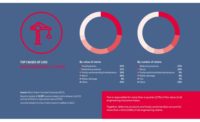Commercial buildings receive the bulk of attention in this issue, but I saw an interesting headline the other day (Energy Consumption by U.S. government at lowest level since at least 1975) and thought it was worth exploring a little more. This came via the U.S. Energy Information Administration, and you can find the full February 4 release at www.eia.gov.
The main graph (representing both military and civilian agencies) is broken into three types of energy, and it may startle you to learn that jet fuel represents almost half of all the energy consumed by the federal government. “Fuels other than jet fuel” is the second and considerably smaller category. And then, of course, the final category is facilities.
The chart’s line doesn’t look so impressive over the long haul, but the end result isn’t bad: the facilities share of that usage has decreased about 50% since 1975, down to “only” 0.4 quadrillion Btu. In terms of energy intensity per sq ft, that number drops from a little over 200,000 Btu/sq ft in 1975 to more like 115,000.
These facilities have been working under or toward a few energy targets and benchmarks. Since 2007, the goal has been a 3% reduction in energy intensity each year, for a 30% total by 2030 compared to the 2003 baseline. Another target comes due this year: to reduce fossil fuel consumption in new and renovated buildings by 65% by this fiscal year.
I would be really interested to hear about any formal energy targets in your own organizations, short- or long-term.
DESKTOP LEARNING
Meanwhile, north of the border, some encouraging info about one of the first things I noticed after joining ES and attending shows like AHR in the late 20th century: “Sure aren’t a lot of women in your typical engineering seminar, are there?”
I’ve seen those seminar rooms improve their mix over the years, and now the University of Toronto’s engineering school reports that women now account for 30.6% of first-year students in their engineering program. That represents a push in the right direction, as they report that 25.8% of their full undergraduate engineering population is female, a number that dips to 19.7% across that province. To compare more broadly, they report those numbers for Canada and U.S. combined at 18.9 and 19.9, respectively, so the progress in Toronto is exemplary.
Up at the front of the classroom, the engineering school has doubled the ranks of female faculty, although that still only translates to 17% of faculty overall. Furthermore, the school states that as of 2013, women represented 11.7% of all professional engineers in that country.
While the undergrad and faculty numbers are growing, the university is also working to grow interested candidates at much earlier ages. They conduct at least half a dozen various programs to engage girls in these subjects, from activities for Girl Guides seeking their Engineering or Physics badges to “Young Women In Engineering” symposia for high school seniors, featuring hands-on workshops and a “Mythbusters” student panel.
A pretty creative, multi-pronged attack on a serious well of untapped talent — nice to see it is yielding some results in Toronto.





